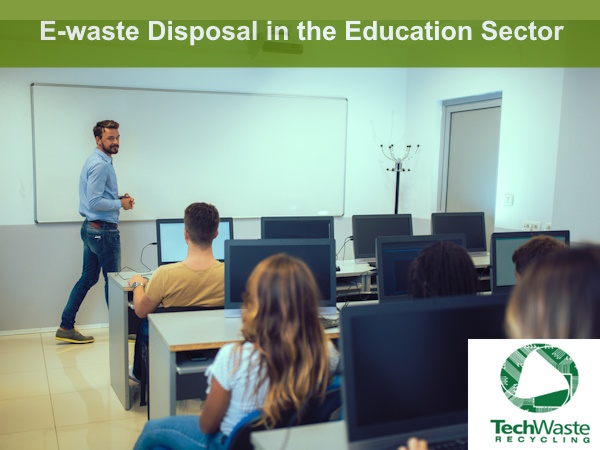Technology has undeniably grown to be a significant part of the education sector. There is a wide variety of technology available, from computers and peripherals to cellphones and tablets, from administration to the classroom. Technology in school districts, colleges, and institutions has a lifecycle just like anything else. It is necessary to dispose of technology when it deteriorates, breaks, or is no longer useful.

E-Waste in Education
Electronic parts and materials are bad for the environment. Additionally, a sizable portion of e-waste can be repurposed. Outdated educational technology contains a significant number of sensitive personal, intellectual, and corporate information.
Educational institutions must continue to abide by privacy rules and use safe data disposal procedures for the electronics end of life electronics even when these are no longer in use.
Teach High School Students About E-Waste
Responsible electronic recycling is a popular strategy in addition to reusing and repairing gadgets. However, not everyone is aware of how to do it or that they can. When teachers include students in civic engagement and teach them useful skills, they can have a significant impact on raising awareness of appropriate electronic recycling.
These are the reasons why you need to teach high school students about e-waste.
It is multidisciplinary and relates to several topics.
The e-waste crisis pulls together a variety of areas, including business, government, and science, making it a reasonably simple topic to integrate while still adhering to your content guidelines. E-waste lessons are beneficial for classes on economics, government and civics, science, and engineering.
It can empower interest in project-based learning.
The majority of e-waste is produced in schools. E-waste increases as affluent schools replace their outdated technology with newer models. Get your students engaged in investigating and establishing an e-waste recycling program if your school doesn’t already have one.
Your class can organize an e-waste drive for the neighborhood even if your school already recycles electronic waste. Students can design fliers to raise awareness and persuade their family members and neighbors to donate their old electronics.
Teaching civic responsibility, critical thinking, and cooperation to students by involving them in the problem-solving process is a terrific idea.
E-waste education can help students develop a sense of global citizenship.
Students require the knowledge and abilities to comprehend the bigger picture and how to solve widespread global issues in today’s globalized society. Knowing about the causes and effects of e-waste will help students know how their activities can affect both local and global communities. They will also learn how to work together across disciplines to develop practical solutions.
Making an Education E-Waste Program Compliant
Compliance means adhering to established laws and regulations. In other words, it entails abiding by the law and its regulations. There are 4 basic steps in making a compliant education e-waste program.
1. Perform a risk assessment. Know the types of technology you have to discard, the types of data stored on those devices, whether or not that data is being retained past its intended purpose, and whether or not these electronics include dangerous elements. Recognizing which rules apply and how to follow them is another step in the review process.
2. Set up procedures and policies. As soon as you are aware of what needs to be done, create a strategy to accomplish it quickly.
3. Find certified partners. Look for a secure, accredited, compliant, and ITAD electronic recycling services firm in your area or nearby.
4. Create a procedure that can be repeated. Inform and acquaint staff with the proper procedures and policies.
Recycle, Reuse, and Recover
The need to reduce the amount of waste dumped in landfills is becoming more urgent. Educational institutions are held to a higher standard because they are responsible for raising the next generation of thought leaders. You may achieve and even exceed these criteria if you work with the right e-waste disposal partner.
How Schools Can Help Minimize E-waste?
Setting up recycling efforts could seem like another time-consuming activity in the education sector, which is well known for having time constraints. Here are some quick this for you to increase your recycling and trash reduction.
Tips for a Successful Electronic Products Recall
Get your students to think about the Environment
Children should be inspired to participate in recycling programs at their schools. There are countless opportunities to incorporate entertaining ideas into teaching environmental awareness, from going on scavenger hunts to discovering recyclable things to challenging kids to bring a lunch without trash.
Recovering and refurbishing as many of your devices as it can, and where appropriate, gives you money back. This ensures that you receive the most value out of the items that are being returned to you.
TechWaste Recycling is an electronic recycling R2-certified company that can handle your e-waste disposal. Call us to schedule a pickup, see service areas we cover.

































